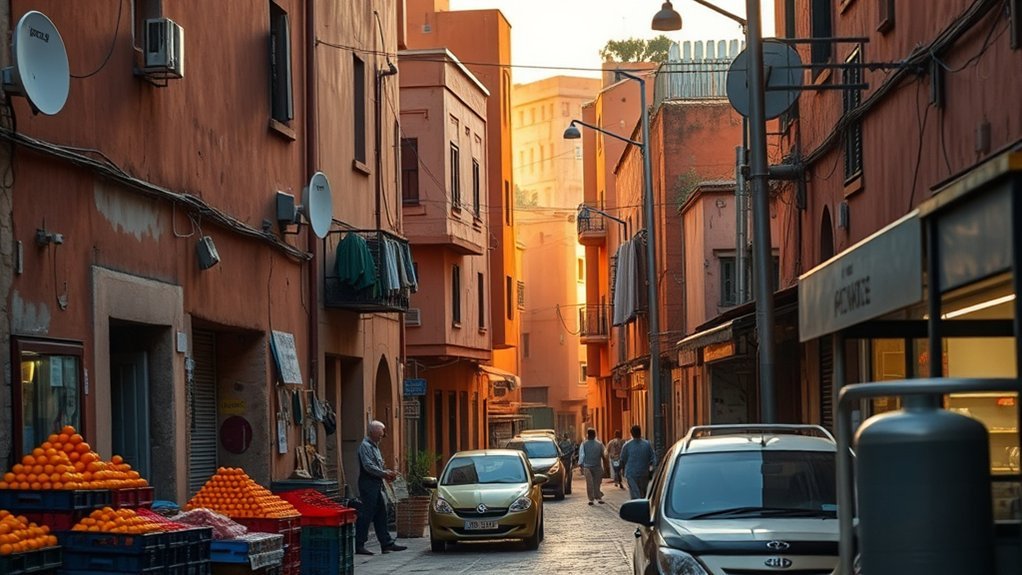You can live cheaply in Morocco: expect about €600/month for a single person and roughly €1,800 for a family of four. Rent varies — city-center one-bed around €320, suburban much less — and utilities are low. Groceries, transport, and eating out are affordable compared with Western Europe, though private healthcare and international schools add costs. Cash is king and cards are used for big purchases. Keep going and you’ll find detailed breakdowns to plan your budget.
Monthly Budget Estimates for Singles and Families
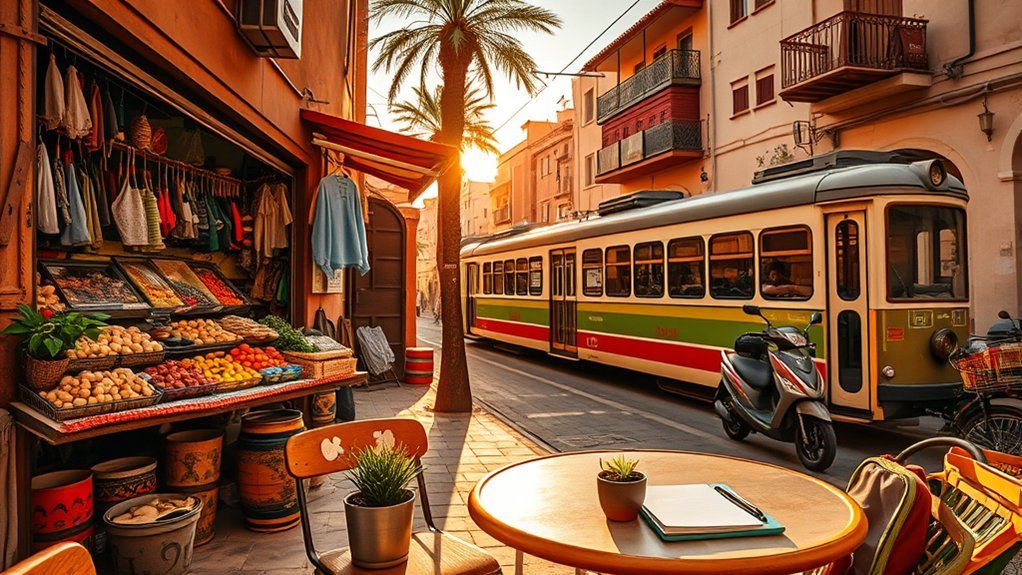
While costs vary by city and lifestyle, you can expect a single person to budget about €600 per month in Morocco, compared with roughly €1,800 for a family of four.
Expect about €600/month for a single person in Morocco, versus roughly €1,800 for a family of four.
You’ll find those monthly costs hinge on housing costs, groceries, utilities and transport. A city-center one-bedroom averages €320, utilities for apartments under 100 m² about €35, so rent plus basics already take a large slice of a single’s budget.
Grocery spending can swing widely—expect 500–1,500 MAD weekly—so your shopping habits will push your living expenses up or down.
Transport is inexpensive: urban bus fares near 5 MAD and taxis starting around 6.85 MAD keep commuting affordable.
For families, multiply housing and grocery needs and allow more for schooling, larger apartments and extra utilities, which explains the roughly €1,800 figure.
Compare these totals to the national average salary (~€22,200/year) to gauge affordability and set realistic budgets.
Currency, Exchange Rates, and Payment Methods
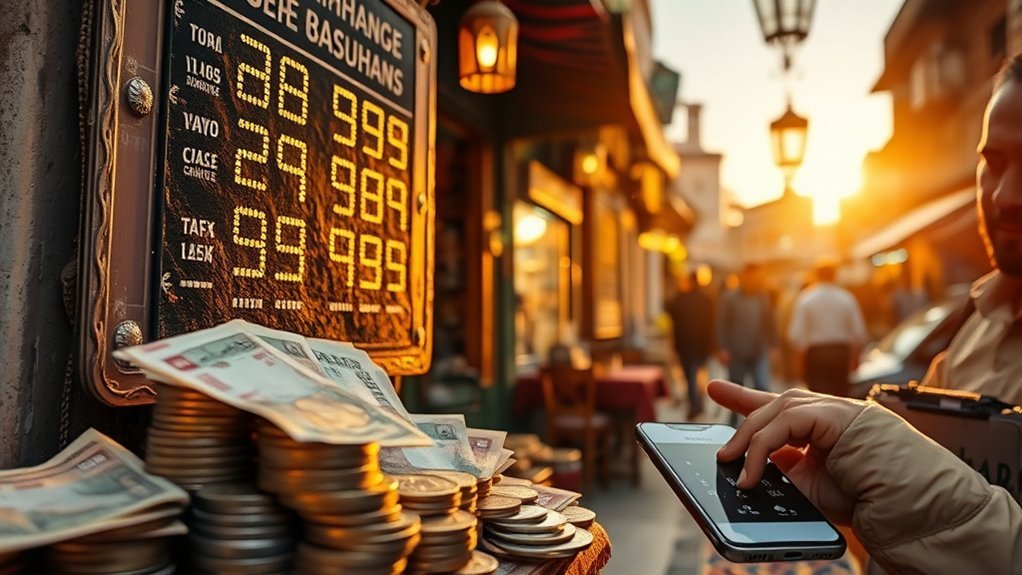
The official currency is the Moroccan dirham (MAD), usually shown as DH, so you’ll want prices quoted in MAD when you budget.
As of June 23, 2025 one MAD ≈ €0.095 (about 10.54 MAD = €1), but rates fluctuate so check local quotes before exchanging.
Cash dominates daily payments in Morocco, so carry dirhams and use cards mainly for larger purchases or at major hotels and shops.
Official Currency and Symbol
Because you’ll handle most transactions in cash, get familiar with the Moroccan dirham (MAD or DH) and current rates — as of June 23, 2025, about 10.54 MAD equals 1 euro (1 MAD ≈ 0.095 EUR). The official currency is the Moroccan dirham (symbol DH). You’ll use cash widely; cards work in cities but aren’t universal. Track the exchange rate for accurate budgeting and to compare costs with home prices. For expatriates and travelers, knowing denominations and typical street/ATM practices saves fees and time.
| Currency | Symbol | Use |
|---|---|---|
| Moroccan dirham | DH / MAD | Daily cash |
| Euro (reference) | € | Comparison |
| ATM / Card | — | Limited acceptance |
Current Exchange Rates
Want to keep your budget accurate? Track current exchange rates: as of June 23, 2025, 1 Moroccan dirham (MAD) equals 0.095 euro (10.54 MAD = 1 EUR).
You’ll see prices listed in dirhams, so divide by roughly 10 to estimate euros quickly. Rates fluctuate, so check before converting big sums—small shifts change monthly expenses and the apparent cost of housing when you compare to European rents.
Since cash dominates local transactions, having dirhams on hand helps you stick to planned spending. For quick comparisons, convert rent and utilities into euros to judge affordability abroad, then reconvert to dirhams for local budgeting.
Keep exchange-rate alerts on to avoid surprises in your monthly expenses.
Common Payment Methods
If you plan to live or travel in Morocco, you’ll need to think in dirhams (MAD) and keep cash on hand: while 1 MAD ≈ €0.095 (10.54 MAD = €1 as of June 23, 2025), most daily purchases—from taxis and souks to small cafés—are paid in cash.
Cards are accepted mainly at larger hotels and shops, and knowing local exchange rates helps you judge costs like a city-center studio (≈3,370 MAD/€320) and avoid surprises when converting rents and bills.
You should prioritize carrying Moroccan dirham for everyday expenses, withdrawing from ATMs or exchanging currency at banks.
Credit/debit cards work for bigger purchases, but acceptance is uneven.
Track exchange rates to compare fees and protect your budget; blending cash and cards minimizes hassle.
Housing Prices and Rental Market by City
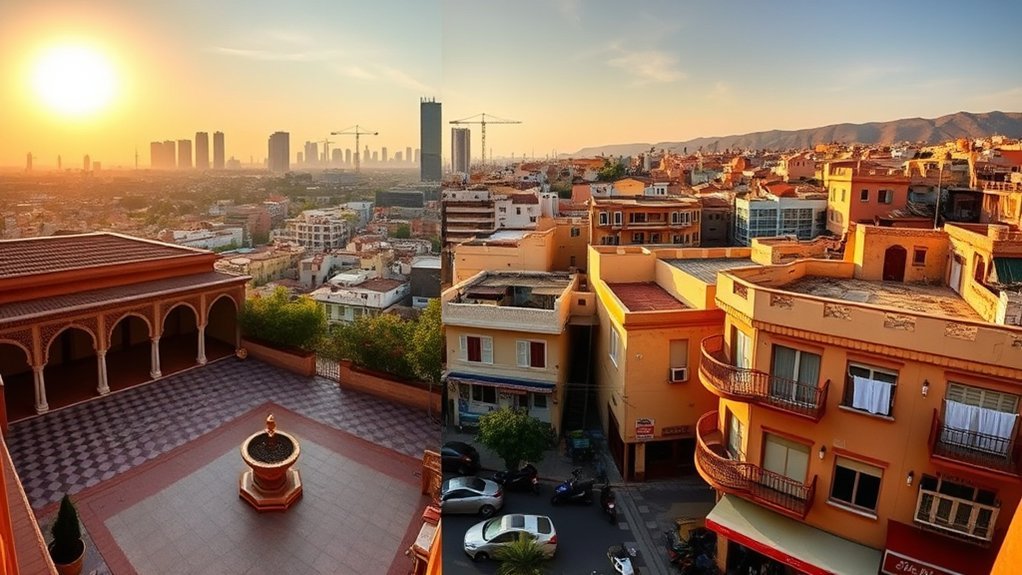
1 clear takeaway: renting in Moroccan cities varies widely by location and quality. You’ll find housing prices and rental prices shift sharply between tourist hubs, urban centers, and rural suburbs.
A one-bedroom apartment in a city center averages about 3,370 MAD (€320), remarkably higher than neighboring Algeria’s roughly €135. If you want furnished places in tourist cities, expect 5,000–6,000 MAD monthly; luxury urban flats can hit 12,000 MAD.
Move to suburban or rural areas and rents drop to around 1,500 MAD, which cuts living costs considerably.
Utilities for apartments under 100 m² average 370 MAD (€35) monthly; in larger cities total utilities often reach 400–600 MAD.
When budgeting, compare neighborhoods: central convenience costs more, while outskirts save you on rent but may add transport expense.
Prioritize what you value—location, furnishings, or space—to balance rent against overall living costs effectively.
Grocery Costs and Eating Out
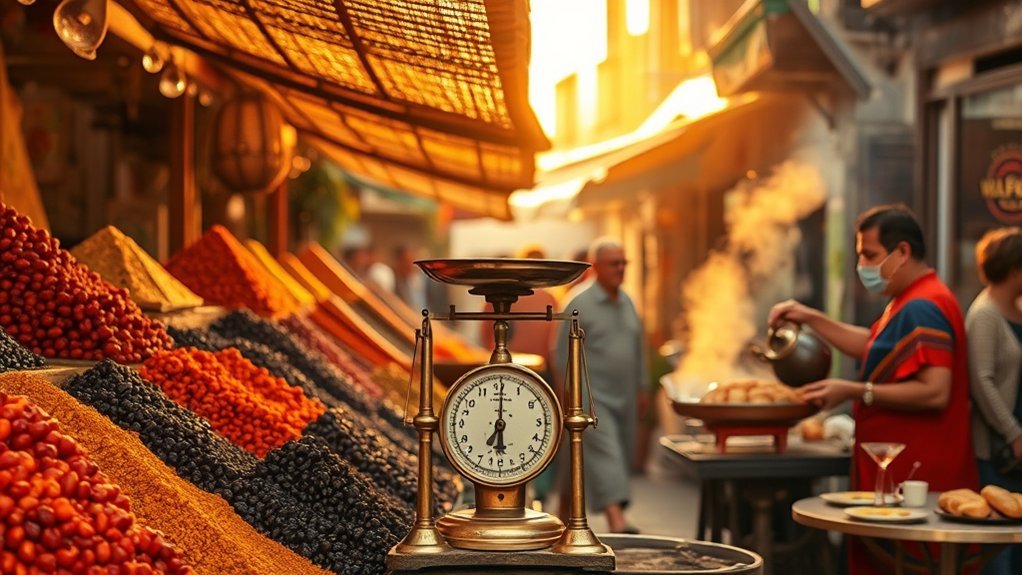
Although grocery bills can stay low when you shop local markets, your weekly food spend will typically fall between 300 and 600 MAD per person depending on whether you favor local produce or imported goods.
You’ll find staples cheap — milk, bread and chicken make basic meals affordable — and buying at souks or neighborhood grocers cuts grocery costs further.
If you prefer European-style or imported items, expect monthly costs to rise: a family often spends 3,000–5,000 MAD on groceries.
For dining out, budget options run 30–100 MAD per meal, while mid-range restaurants cost about 150–300 MAD per person, so you can mix home cooking with occasional meals out without much strain.
Compare prices between local markets and supermarkets: markets win on price and freshness; chains help when you need specific imports.
Plan a weekly menu, shop markets early, and reserve dining out for weekends to keep overall food spending predictable and manageable.
Transportation, Fuel, and Local Travel Expenses
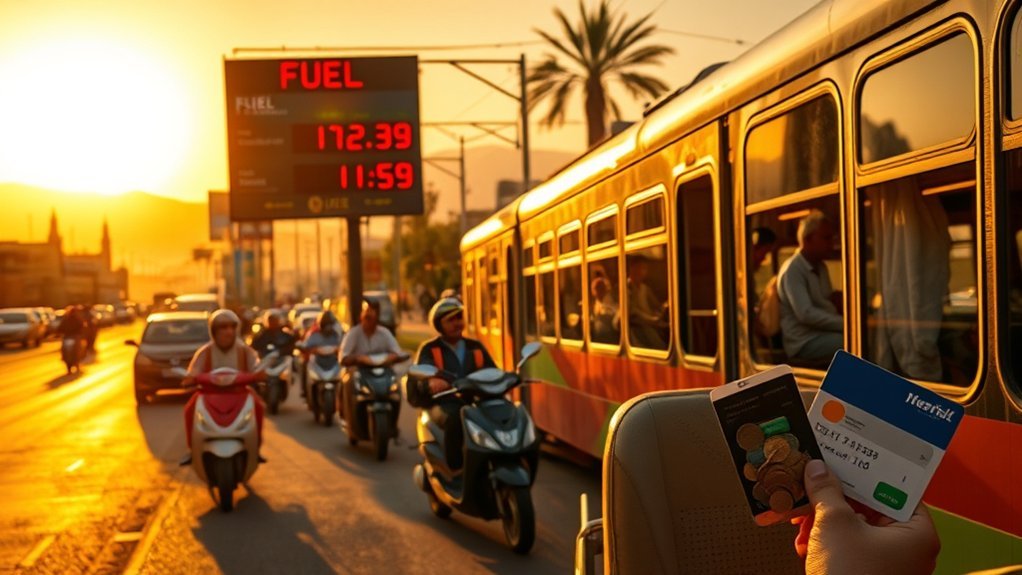
You’ll find public transport is very affordable for city travel — buses cost about 5 MAD per ride and taxis start around 6.85 MAD plus roughly 6.85 MAD/km.
Petrol sits near 14.25 MAD per litre, so driving or long commutes add up quickly compared with city transit.
For intercity trips plan for higher fares (buses up to ~300 MAD, trains like Casablanca–Rabat about 340 MAD) and weigh time versus cost when choosing.
Public Transport Costs
Public transport in Morocco is affordable for everyday travel but costs can add up depending on how you move around: urban buses typically charge about 5 MAD (€0.50) per ride.
Inter-city buses can reach roughly 300 MAD (€28.50) for long routes, and taxis start around 6.85 MAD (€0.65) plus about 6.85 MAD/km.
You’ll find urban bus fares are ideal for short commutes and city budgeting, while inter-city bus fares give a low-cost option compared with trains.
Train fares vary by distance; a second-class ticket Casablanca–Rabat is about 340 MAD (€32.25), so choose buses for savings on medium routes.
Renting a car costs roughly 5,000 MAD/month, so if you rely on public transport you can cut monthly travel costs considerably.
Fuel Prices Overview
If you’re budgeting travel in Morocco, fuel prices play a big role alongside bus, taxi and train costs.
At about MAD 14.25 (€1.35) per litre, the petrol price is moderate compared with Western Europe, but it still shifts your transportation expenses if you drive often.
If you rent a car in Morocco for roughly MAD 5,000 per month, factor in monthly fuel use to compare with regular bus (≈5 MAD) or local taxi starts (MAD 6.85 plus MAD 6.85/km).
For short urban trips, public transport remains cheaper; for routine commutes or rural access, owning or renting a car may be competitive once you add petrol price to rental and maintenance costs.
Intercity Travel Options
When planning trips between Moroccan cities, weigh cost against convenience: buses average about 300 MAD (€28.50) and give the best value for most routes, trains are faster and more comfortable with fares like Casablanca–Rabat at roughly 340 MAD (€32.25), while domestic flights (e.g., Casablanca–Agadir) jump to around 1,200 MAD (€115) and only pay off for long distances or time-sensitive travel. You’ll find intercity travel options range from budget buses to pricier planes; taxis start at about 6.85 MAD plus 6.85 MAD/km, and petrol costs around 14.25 MAD/l. Use public transportation where possible; driving suits flexibility but increases costs. Compare time, comfort, and costs around your itinerary across cities in Morocco.
| Mode | Typical Fare | Best for |
|---|---|---|
| Bus | 300 MAD | Budget travel |
| Train | 340 MAD | Comfort/speed |
| Flight | 1,200 MAD | Long distances |
Healthcare, Insurance, and Medical Costs
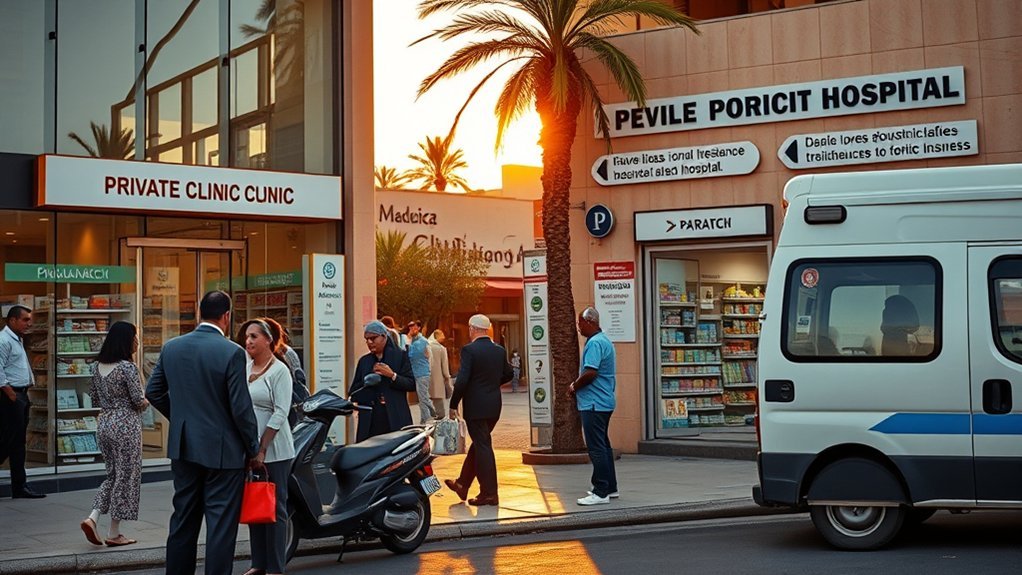
Although Morocco’s public system exists, most expats choose private care because it’s faster and often better equipped, especially in cities; expect consultation fees around 200–400 MAD per visit, while prescriptions remain relatively affordable compared with Western prices.
You’ll find private healthcare preferred by expatriates for reliability and equipment, and medical costs are generally lower than in many Western countries.
International health insurance varies widely — roughly 1,500–5,000 MAD annually depending on coverage — so compare deductibles, network hospitals, and emergency evacuation.
International health insurance costs vary — expect roughly 1,500–5,000 MAD yearly; compare deductibles, hospital networks, and evacuation cover.
Keep your home-country policy until you get a Moroccan residence card to avoid coverage gaps.
In cities you’ll access specialists and private clinics easily; in rural areas options shrink and travel adds cost.
For routine care, out-of-pocket spending plus modest insurance gives strong value versus Western premiums.
If you have chronic conditions, confirm medication availability and prices in advance and choose a plan that covers local private clinics and repatriation if needed.
Education and Schooling Expenses for Families
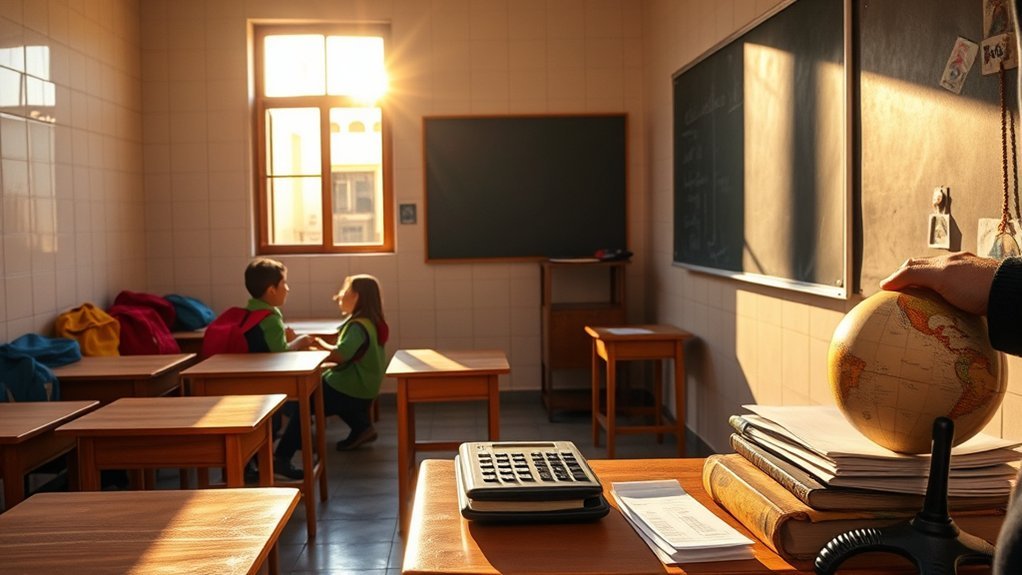
Curious how much schooling will add to your Morocco budget? If you prefer private schools, expect premium networks to cost about 50,000 dirhams per year per child; other reputable private schools typically fall between 20,000 and 30,000 dirhams.
AEFE/OSUI and international options (Belgian, American) serve expatriate families seeking familiar curricula and language instruction. Public schools are cheaper but may not meet your expectations for language or curriculum quality.
Beyond tuition, budget for uniforms, supplies, and extracurriculars — these schooling expenses can add several thousand dirhams annually and sometimes justify choosing schools that offer sibling discounts or bundled fees.
If you have multiple children, compare networks for multi-enrollment discounts. Factor in transport if the school’s location matters.
Leisure, Entertainment, and Lifestyle Spending
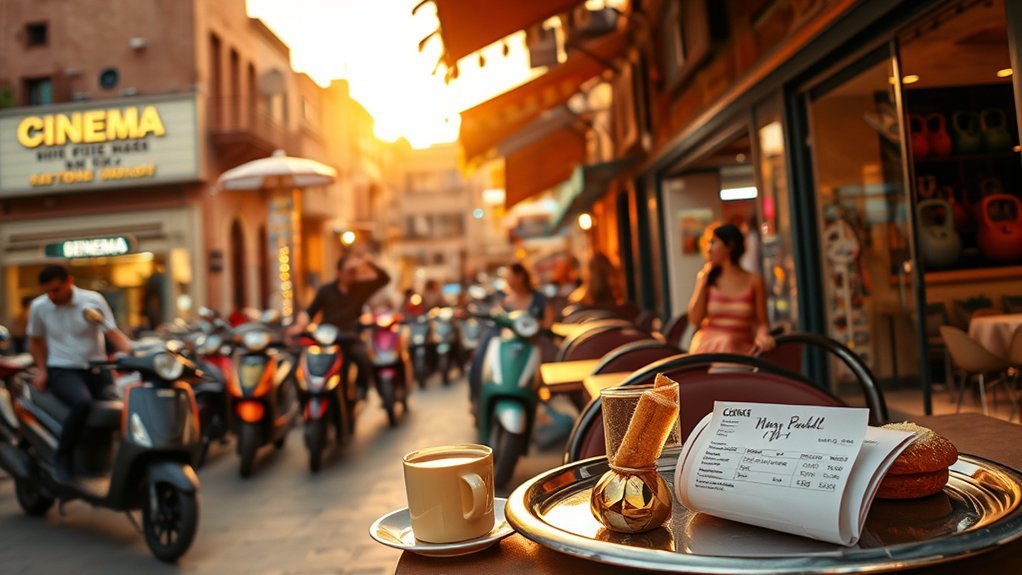
Want to know how much life outside the home will add to your monthly budget? Leisure activities and entertainment in Morocco cost more than in neighboring Algeria, so plan accordingly.
Curious how leisure affects your monthly budget? Entertainment in Morocco is pricier than in neighboring Algeria—plan accordingly.
Cinema tickets run about 70 MAD, while mid-range dining out typically costs 150–300 MAD per person. You can cut costs by using local markets and street food—meals there often fall between 30–100 MAD.
Gym memberships vary widely, usually 200–600 MAD monthly depending on facilities and location.
- Cinema: ~70 MAD per ticket — affordable for occasional outings.
- Dining out: 150–300 MAD at mid-range restaurants; street food 30–100 MAD.
- Fitness: gym memberships 200–600 MAD/month based on amenities.
- Transport & travel: buses 4–10 MAD; taxis 20–50 MAD; domestic trips add up.
If you prioritize budget-friendly choices like local markets, you’ll enjoy Morocco’s lifestyle without overspending on entertainment and leisure activities.
Frequently Asked Questions
Can US Citizens Live in Morocco?
Yes — you can live in Morocco if you obtain a long-term residency visa; you’ll need to prove income or stability, register locally, and adapt to lower living costs, often finding housing, healthcare, and daily expenses more affordable than the US.
How Much Money Do You Need to Retire in Morocco?
You’ll need roughly €600/month as a single retiree for a comfortable basic lifestyle, while a family might require €1,800/month; plan for at least ~2,698 MAD (€260) minimum pension, more if you prefer private healthcare or schooling.
What Is the Average Rent in Morocco?
“Don’t judge a book by its cover.” You’ll find average city-center one-bedroom rent around 3,370 MAD (€320); studios vary 3,000–7,000 MAD, suburbs start near 1,500 MAD, and luxury can reach 12,000 MAD.
Is Morocco Expensive for Americans?
No, Morocco isn’t expensive for Americans; you’ll find lower rents, cheap groceries and affordable transport. You’ll stretch dollars farther than in many Western cities, though costs vary by city, lifestyle, and whether you live centrally or outskirts.
Conclusion
Living in Morocco can be gentle on your wallet or pricier depending on choices: you’ll pay far less outside Casablanca and Rabat, save on groceries by shopping local, and cut transport costs with buses and shared taxis. Healthcare and schools vary — public options are cheaper but private quality costs more. When you balance housing, food, and leisure, you’ll find the sweet spot between comfort and economy; don’t bite off more than you can chew.

